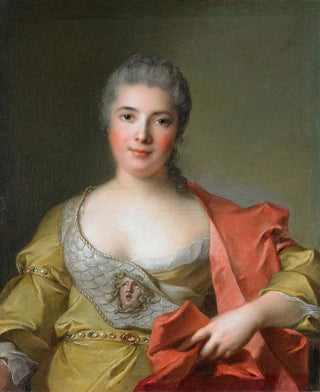Art print | Honorée Julie Mirleau de Neuville - Jean-Marc Nattier


View from behind

Frame (optional)
In the refined world of the 18th century, where art and society intertwine with unmatched elegance, the art print "Honorée Julie Mirleau de Neuville" by Jean-Marc Nattier stands as a vibrant testament to that era. This painting not only evokes the beauty and grace of a woman but also embodies the aesthetic values of a time when portraiture was a means of asserting social status. Through this art print, we are invited to immerse ourselves in the universe of Louis XV's court, a place where art reflected the aspirations and dreams of the elites.
Style and uniqueness of the work
Nattier's work is distinguished by its delicate style and ability to capture the very essence of its subjects. In "Honorée Julie Mirleau de Neuville," the composition is carefully orchestrated, with every detail, from the draping of the clothing to facial expressions, contributing to an atmosphere of distinction. The chosen colors are both soft and luminous, revealing a mastery of nuances that gives the canvas a fascinating depth. The play of light and shadow, characteristic of rococo, adds an almost living dimension to the depicted figure. The artist thus manages to transcend mere representation to offer a true sensory experience, where one can almost feel the texture of fabrics and the warmth of human presence.
The artist and his influence
Jean-Marc Nattier, often regarded as the portraitist of women of his time, successfully established himself in the 18th-century artistic landscape thanks to his exceptional talent. Trained in his father's workshop and influenced by the great masters of painting, Nattier developed a style that is uniquely his own, combining finesse and sophistication. His works are not limited to simple representations but tell stories, evoke emotions, and reveal personalities. The artist captured the spirit of his era, making his portraits objects of desire and contemplation. The impact of his work transcends his time, inspiring many artists who followed him and helping to define the standards of female portraiture within French art.

Matte finish

View from behind

Frame (optional)
In the refined world of the 18th century, where art and society intertwine with unmatched elegance, the art print "Honorée Julie Mirleau de Neuville" by Jean-Marc Nattier stands as a vibrant testament to that era. This painting not only evokes the beauty and grace of a woman but also embodies the aesthetic values of a time when portraiture was a means of asserting social status. Through this art print, we are invited to immerse ourselves in the universe of Louis XV's court, a place where art reflected the aspirations and dreams of the elites.
Style and uniqueness of the work
Nattier's work is distinguished by its delicate style and ability to capture the very essence of its subjects. In "Honorée Julie Mirleau de Neuville," the composition is carefully orchestrated, with every detail, from the draping of the clothing to facial expressions, contributing to an atmosphere of distinction. The chosen colors are both soft and luminous, revealing a mastery of nuances that gives the canvas a fascinating depth. The play of light and shadow, characteristic of rococo, adds an almost living dimension to the depicted figure. The artist thus manages to transcend mere representation to offer a true sensory experience, where one can almost feel the texture of fabrics and the warmth of human presence.
The artist and his influence
Jean-Marc Nattier, often regarded as the portraitist of women of his time, successfully established himself in the 18th-century artistic landscape thanks to his exceptional talent. Trained in his father's workshop and influenced by the great masters of painting, Nattier developed a style that is uniquely his own, combining finesse and sophistication. His works are not limited to simple representations but tell stories, evoke emotions, and reveal personalities. The artist captured the spirit of his era, making his portraits objects of desire and contemplation. The impact of his work transcends his time, inspiring many artists who followed him and helping to define the standards of female portraiture within French art.






